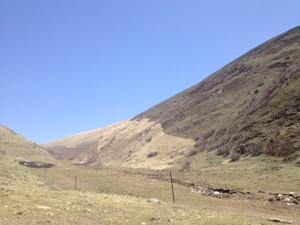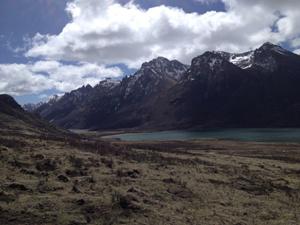Li Li
The project aims to evaluate the impacts of pasture land-use changes on alpine avian habitats in Nyanpo Yutse Mountain region. We will conduct the breeding season bird survey and work with local herders to develop a community conservation plan for birds.

Winter pasture fencing in a Tibetan Bunting habitat. ©Li Li.
Nyanpo Yutse covers 900 km² protective area above 3800 m.a.s.l. It provides critical habitats for 148 alpine birds, including endangered species black-necked crane, white eared-pheasant, Tibetan bunting etc. Many local birds are grassland specialists and are sensitive to livestock grazing. On the eastern Qinghai-Tibetan Plateau, animal husbandry is the predominant industry. However, the pastoral land-use practices have been changed to a great extent during the past decades. In Nyanpo Yutse the total stocking rate has tripled since 1960. After the 1990s, herders started to set up fences after grassland privatisation which caused grassland fragmentation and pastoral mobility loss.

Habitat for White-tailed Rubythroat on Omtso summer pasture. ©Li Li.
Considering grassland management being the key issue of the alpine habitat protection, we plan to promote herders’ participation in bird conservation in Nyanpo Yutse. We are interested to understand correlations among grazing intensity, plateau pika density and the present avian richness distribution of the study area. We also hope the project can improve the integration of indigenous knowledge into conservation planning.
We will achieve the project goals through building cooperation between ecologists and local stakeholders. Firstly, the project will reconstruct the land-use change processes in Nyanpo Yutse from the 1970s to the present. Through conducting elder-herders’ interviews we will map pasture usage changes and measure historical land-use intensities quantitatively.
Secondly, we will carry out the breeding season bird survey in different land-use pastures by setting up around 200 counting points on seasonal pastures. The survey will provide the first baseline of the species composition of alpine avian communities across the landscape. We will understand the impact of livestock grazing on spatial distributions of bird richness and pika density.
Finally, we will draft the “Nyanpo Yutse Community Conservation Plan for Alpine Birds” together with the local NGO Nyanpo Yutse Environment Protection Association. In the plan, we will identify key habitats for protective birds and designate community conserved areas.
Nyanpo Yutse is one of the 18 core zones of the Sanjiangyuan national nature reserve which covers 152,300 km². We expect that the project will provide a good bottom-up conservation planning practice for the whole region. We will make careful documentation of the working protocol and draft a project report to the nature reserve’s management office. We hope the experience of our project in Nyanpo Yutse could be shared to other similar pastoral ecosystems of the Sanjiangyuan region.